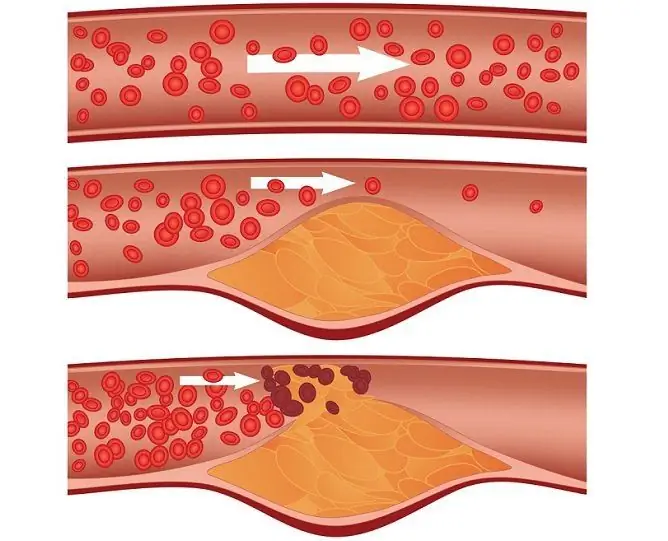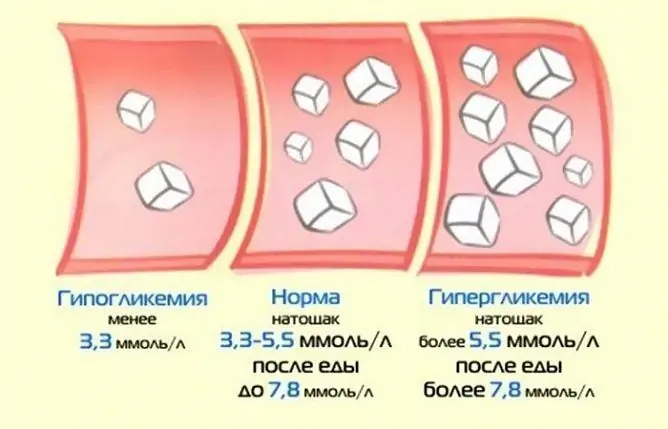- Author Rachel Wainwright [email protected].
- Public 2023-12-15 07:39.
- Last modified 2025-11-02 20:14.
Perioral dermatitis
The content of the article:
- Causes of perioral dermatitis and risk factors
- Forms of the disease
- Symptoms
- Features of the course of the disease in children
- Diagnostics
- Perioral dermatitis treatment
- Diet for perioral dermatitis
- Possible complications and consequences
- Forecast
- Prevention
Perioral dermatitis (rosacea-like dermatitis, perioral dermatitis, steroid dermatitis, flight attendant disease) is a chronic recurrent inflammatory skin disease in which the skin around the mouth is mainly affected, less often the cheeks, nose, lower eyelids and forehead. A typical manifestation of perioral dermatitis is that the strip of skin that is adjacent to the red border of the lips is not affected.
The first cases of the disease were recorded in the 50s of the XX century. In recent years, the incidence of perioral dermatitis has decreased, and now it is diagnosed in about 1% of the population. Persons with fair skin are more prone to perioral dermatitis. The disease mainly affects women aged 20-40 years, but it also occurs in males. Children are susceptible to this type of dermatitis, regardless of gender.

Perioral dermatitis symptoms
Causes of perioral dermatitis and risk factors
The causes of perioral dermatitis are not fully understood.
The disease often develops against the background of the use of local drugs, which include corticosteroids, to treat other dermatological pathologies (acne, acne, rosacea, eczema, etc.). Also, the occurrence of perioral dermatitis can be promoted by chapping of the skin of the face, prolonged exposure to direct sunlight, excessive use of decorative cosmetics, especially of low quality.
Risk factors for developing perioral dermatitis include:
- diseases of the gastrointestinal tract;
- neurological disorders;
- chronic infectious processes;
- hormonal disorders;
- taking oral contraceptives;
- allergic reactions;
- decreased immunity;
- stress;
- hypovitaminosis (especially deficiency of vitamins A and E);
- increased sensitivity of the facial skin;
- using a fluoride toothpaste;
- wearing dentures;
- change of climatic conditions.
In children, perioral dermatitis can occur during teething, with increased salivation, with prolonged use of the nipple, as well as with the use of inhalers or sprays that contain hormones.
Forms of the disease
Depending on the characteristics of the clinical picture, there are two main forms of perioral dermatitis - common and granulomatous (occurs mainly in children).
Symptoms
The disease debuts with the appearance of bright red or pink elevations on the skin around the mouth, which resemble acne. Further, the pathological process may involve areas of the skin of the cheeks, nose, forehead and lower eyelid. The elements of the rash are characterized by fusion with each other with the formation of clusters or solid spots. Some elements may be filled with a clear liquid, after breaking out, such a rash will turn into abscesses. The rash can be accompanied by itching, burning, pain, and skin tightness. Usually the rash is localized on the skin of the face symmetrically on the right and left sides. Swelling of the affected skin is often noted. With the progression of the pathological process, the affected areas become covered with scales and crusts, which eventually disappear. Premature peeling off of the crusts can lead to hyperpigmentation, and the resulting pigmentation spots are difficult to remove afterwards.

Perioral dermatitis debuts with a pink spot around the mouth, resembling acne
A characteristic sign of perioral dermatitis is a strip of skin about 4 mm wide around the red border of the lips, which is never involved in the pathological process.
Features of the course of the disease in children
Perioral dermatitis in children up to puberty usually occurs in granulomatous form. This form of the disease differs in the nature of the rash and their localization.
The elements of the rash in the granulomatous form of perioral dermatitis in children are flesh-colored, but sometimes pink or yellowish-brown. In most cases, rashes in children with this form of the disease are not accompanied by any subjective sensations, however, in rare cases, the pathological process may be accompanied by a burning sensation of the affected skin. The elements of the rash can be either single or merge, forming clusters. In addition to the area around the mouth, rashes can be localized around the eyes, near the auricles, on the scalp, on the external genitals, as well as on the skin of the upper and lower extremities.
Diagnostics
To diagnose perioral dermatitis, anamnesis, physical examination and dermatoscopy are performed. In some cases, a histological examination may be required. If there is a suspicion of a secondary infection and the need to identify an infectious agent, bacteriological inoculation of scrapings from the affected areas of the skin and / or the contents of the elements of the rash is performed. The specific causative agent of perioral dermatitis has not been established. In patients, increased contamination of the skin with microorganisms, as well as fungi of the genus Candida, acne (Demodex folliculorum) can be found.

Dermatoscopy is performed to diagnose perioral dermatitis
Differential diagnosis of perioral dermatitis with diseases such as sarcoidosis, rosacea, atopic dermatitis, seborrheic dermatitis, acne, eczema, herpes simplex, demodicosis, acne vulgaris is required.
Perioral dermatitis treatment
When confirming the diagnosis, the first step is to stop taking medications that contain corticosteroids. In addition, you should stop using decorative cosmetics and toothpaste containing fluoride. During treatment, it is recommended to avoid exposure to direct sunlight, and in the summer to use sunscreen.
Treatment of perioral dermatitis is medication. In the presence of itching, antihistamines are indicated, and the use of sedatives may also be required. With pronounced swelling, diuretic drugs may be prescribed. When a bacterial infection is attached, local or systemic antibiotics are used. The intake of vitamin complexes, immunomodulators is shown.
For the local treatment of perioral dermatitis, drugs with a cooling effect in the form of a cream are used, as well as infusions of medicinal plants (calendula, chamomile, celandine, St. John's wort, etc.), lotions from a solution of boric acid.

Drug treatment of perioral dermatitis with sedatives, antihistamines, antibacterial agents, immunomodulators
Treatment of perioral dermatitis lasts from several weeks to several months, depending on the severity of the pathological process. Since the disease is prone to recurrence (especially when using cosmetics, lowering immunity and changing climatic conditions), patients are advised to follow preventive measures.
Diet for perioral dermatitis
For perioral dermatitis, patients are advised to follow a hypoallergenic (mainly plant-based) diet. In the absence of a therapeutic effect, the diet can be replaced by therapeutic fasting according to an individually selected scheme.
The diet is recommended to include cereals, legumes, lean meat (boiled in water or steamed), dairy products, wholemeal bread, green vegetables and fruits. You should stop drinking tea, coffee, alcoholic beverages, citrus fruits, eggs, mushrooms, fish, sausage products, canned food, yeast dough products, spices, limit the use of salt and sugar. To normalize metabolism, patients need a plentiful drinking regime.
In some cases, intestinal cleansing by means of enterosorbents, therapeutic enemas is required.

For perioral dermatitis, a hypoallergenic diet and an abundant drinking regime are recommended.
Possible complications and consequences
Perioral dermatitis is characterized by a recurrent course, while with relapses of the disease, more intense rashes and painful sensations accompanying the appearance of a rash can be observed.
With inadequate treatment of perioral dermatitis, age spots and scars may remain on the skin.
Cosmetic problems and discomfort experienced by patients with perioral dermatitis can lead to psychological problems, neuroses, and depression.
Forecast
With timely diagnosis and properly selected treatment, the prognosis is favorable.
Prevention
In order to prevent the development of perioral dermatitis, it is recommended:
- timely treatment of diseases of internal organs, especially of the digestive system;
- avoiding the use of drugs for external use (ointments, creams), which include corticosteroids;
- refusal to abuse decorative cosmetics;
- refusal to use low-quality cosmetics;
- refusal to use fluoride toothpastes;
- rational nutrition (with limitation of fatty, salty, spicy foods, alcoholic beverages);
- compliance with the rules of personal hygiene.
YouTube video related to the article:

Anna Aksenova Medical journalist About the author
Education: 2004-2007 "First Kiev Medical College" specialty "Laboratory Diagnostics".
The information is generalized and provided for informational purposes only. At the first sign of illness, see your doctor. Self-medication is hazardous to health!






